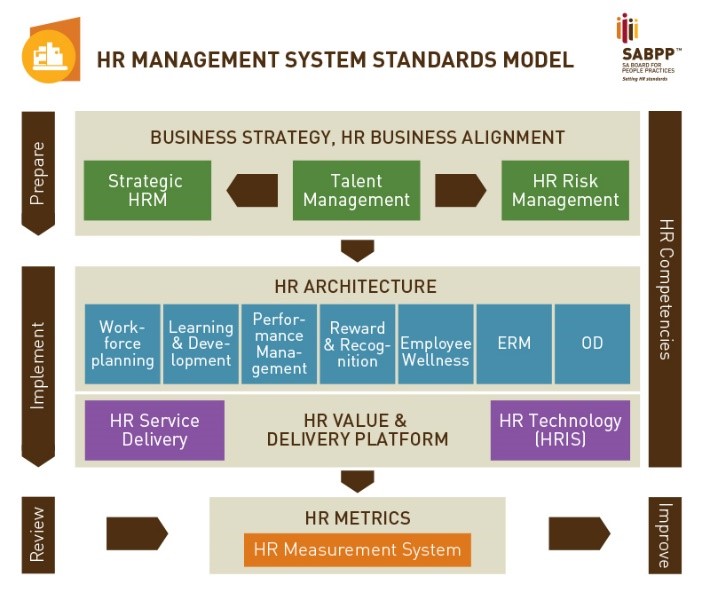
The recent publication titled, Human Resource Management in the New World of Work, edited by Professor Deseré Kokt (2020), aims to provide readers with an outline and understanding of the challenges of the fourth industrial revolution (4IR) and industry 4.0 for human resource management (HRM). It also aims to contextualise these in the South African social and economic environment, and in relation to the SABPP National HR Standards. The layout of the chapters is based on the SABPP HR Management System Standards Model, as illustrated below.
The publication begins with an outline of the role of HR as a strategic partner in the new world of work in chapter one. It lays out the critical need for alignment between the HR strategy and the business strategy (as indicated in the SABPP Strategic HRM Standard). The chapter focuses in on culture and workforce planning. The technologies shaping the new world of work, the competencies required for it, and the South African context are discussed in chapter two.
The chapter first discusses the different phases of industrialisation to contextualise 4IR, making reference to the work of Charles Schwab of the World Economic Forum, and then lists the typical technologies associated with 4IR such as artificial intelligence and internet of things (IOT).

Source: SABPP HR Management Systems Standards Model
Artificial intelligence is cited as an example of the new world of work through the subsequent chapters on talent management (including issues related to recruitment, selection, and leadership) and the aspects of the HR architecture such as workforce planning, learning and development, and reward and recognition. The chapters cite several reports and enumerates variously on how artificial intelligence together with automation is changing the nature of work and the competencies required by organisations and the HR function.
The three chapters on talent management unpack for the reader the HR processes for acquisition, assessment, development, reward, retention, and wellness in organisations. It cites considerations on how the changing world of work and digitalisation will impact these HR processes. This is taken further in the chapter on HRIS where the need for Digital HR is discussed in relation to digital business models and digital transformation. Digital HR “entails configuring the operational HR processes to become automated, data-driven and technologically sophisticated” (p109). The following chapter on HR measurement helps to develop a framework for measurement and details metrics that can be used for the entire HR value chain to provide the required data for Digital HR. The chapter on HR risk management helps to locate Digital HR within corporate good governance and due diligence.
Given its aim and stated scope, the publication can serve as an introduction for students to the HRM issues in the new world of work and South African context. It can similarly serve as an introduction for HR practitioners as it includes, importantly, the discussion on the issues in HR service delivery such as business partnering, client-centrism, and innovation, which is supported by the detailed metrics for the HR value chain. The publication can also serve as a launchpad for students and HR practitioners to further research the HRM issues identified in the individual chapters. The authors, for example, cite select reports from the World Bank, World Economic Forum and Deloitte Human Capital Trends (2017 edition). Utilising these and the recent reports from these institutions, the reader – particularly postgraduate students and HR specialists and HR practitioners at the Chartered and Master professional designation levels – can then explore other reports and scholarly research that provide critical examinations of the 4IR construct, related technologies such as artificial intelligence, the changing nature of work and forms employment, and the implications thereof including issues such as the digital divide and just transition. As an example, the reader could explore the advantages and disadvantages of artificial intelligence and automation in talent assessment, but, more importantly, he or she should explore and critically examine the problematic assumptions that inform it and the related ethical considerations.
Future publications on the new world of work and HRM could consider having dedicated chapters on the design of the HR function (particularly in relation to the transformations in the competitive landscape and business models) and organisation development. This could help the reader to draw together the various discussion threads on digital technologies and transformation; digital workforce, workplace, and HR; culture; leadership; and talent. It could also help the HR practitioner in drawing up a roadmap and designing coherent, systemic interventions to address the opportunities, challenges, and barriers related to the fourth industrial revolution (4IR) and industry 4.0.
Review by Dr Ajay Jivan
Dr Ajay Jivan is the SABPP Head of Research, Quality Assurance, HR Audits and Financial Controls. He is also a registered Psychologist and Director at Vantage Lab (https://vantage-lab.com/), which helps clients navigate the changing strategic landscape and co-evolve their leadership and human capital strategies, development and research.


